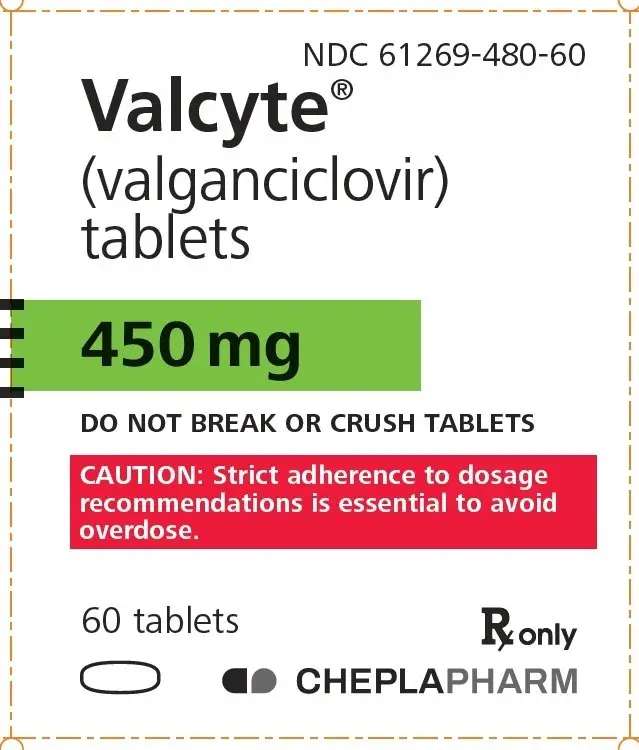Drug Detail:Valcyte (Valganciclovir [ val-gan-sye-kloe-veer ])
Drug Class: Purine nucleosides
Highlights of Prescribing Information
VALCYTE (valganciclovir) tablets, for oral use
VALCYTE (valganciclovir) for oral solution
Initial U.S. Approval: 2001
WARNING: HEMATOLOGIC TOXICITY, IMPAIRMENT OF FERTILITY, FETAL TOXICITY, MUTAGENESIS AND CARCINOGENESIS
See full prescribing information for complete boxed warning.
- Hematologic Toxicity: Severe leukopenia, neutropenia, anemia, thrombocytopenia, pancytopenia, and bone marrow failure including aplastic anemia have been reported in patients treated with VALCYTE. (5.1)
- Impairment of Fertility: Based on animal data and limited human data, VALCYTE may cause temporary or permanent inhibition of spermatogenesis in males and suppression of fertility in females. (5.3)
- Fetal Toxicity: Based on animal data, VALCYTE has the potential to cause birth defects in humans. (5.4)
- Mutagenesis and Carcinogenesis: Based on animal data, VALCYTE has the potential to cause cancers in humans. (5.5)
Indications and Usage for Valcyte
VALCYTE is a deoxynucleoside analogue cytomegalovirus (CMV) DNA polymerase inhibitor indicated for:
Adult Patients (1.1)
- Treatment of CMV retinitis in patients with acquired immunodeficiency syndrome (AIDS).
- Prevention of CMV disease in kidney, heart, and kidney-pancreas transplant patients at high risk.
Pediatric Patients (1.2)
- Prevention of CMV disease in kidney and heart transplant patients at high risk.
Valcyte Dosage and Administration
| Adult Dosage (2.2) | |
| Treatment of CMV retinitis | Induction: 900 mg (two 450 mg tablets) twice a day for 21 days Maintenance: 900 mg (two 450 mg tablets) once a day |
| Prevention of CMV disease in heart or kidney-pancreas transplant patients | 900 mg (two 450 mg tablets) once a day within 10 days of transplantation until 100 days post-transplantation |
| Prevention of CMV disease in kidney transplant patients | 900 mg (two 450 mg tablets) once a day within 10 days of transplantation until 200 days post-transplantation |
| Pediatric Dosage (2.3) | |
| Prevention of CMV disease in kidney transplant patients 4 months to 16 years of age | Dose once a day within 10 days of transplantation until 200 days post-transplantation according to dosage algorithm (note the calculation of creatinine clearance using a modified Schwartz formula in children) |
| Prevention of CMV disease in heart transplant patients 1 month to 16 years of age | Dose once a day within 10 days of transplantation until 100 days post-transplantation according to dosage algorithm (note the calculation of creatinine clearance using a modified Schwartz formula in children) |
- VALCYTE for oral solution and tablets should be taken with food. (2.1, 12.3)
- VALCYTE tablets should not be broken or crushed. (2.6)
- Adult patients should use VALCYTE tablets, not VALCYTE for oral solution. (2.1)
- Adults with renal impairment: Adjust dose based on creatinine clearance. For adult patients receiving hemodialysis a dose recommendation cannot be given. (2.5, 8.6, 12.3)
Dosage Forms and Strengths
- Tablets: 450 mg. (3)
- Oral Solution: 50 mg per mL. (3)
Contraindications
Hypersensitivity to valganciclovir or ganciclovir. (4)
Warnings and Precautions
- Acute renal failure: Acute renal failure may occur in elderly patients (with or without reduced renal function), patients who receive concomitant nephrotoxic drugs, or inadequately hydrated patients. Use with caution in elderly patients or those taking nephrotoxic drugs, reduce dosage in patients with renal impairment, and monitor renal function. (2.5, 5.2, 8.5, 8.6)
Adverse Reactions/Side Effects
- Adult patients: Most common adverse reactions and laboratory abnormalities (reported in at least one indication by greater than or equal to 20% of patients) are diarrhea, pyrexia, fatigue, nausea, tremor, neutropenia, anemia, leukopenia, thrombocytopenia, headache, insomnia, urinary tract infection, and vomiting. (6.1)
- Pediatric patients: Most common adverse reactions and laboratory abnormalities (reported in greater than or equal to 20% of pediatric solid organ transplant recipients) are diarrhea, pyrexia, upper respiratory tract infection, urinary tract infection, vomiting, neutropenia, leukopenia, and headache. (6.1)
To report SUSPECTED ADVERSE REACTIONS, contact 1-866-946-3684 or FDA at 1-800-FDA-1088 or www.fda.gov/medwatch.
Drug Interactions
- Imipenem-cilastatin: Seizures were reported in patients receiving ganciclovir and imipenem-cilastatin. Concomitant use is not recommended unless the potential benefits outweigh the risks. (7)
- Cyclosporine or amphotericin B: When coadministered with valganciclovir, the risk of nephrotoxicity may be increased. Monitor renal function. (5.2, 7)
- Mycophenolate mofetil (MMF): When coadministered with valganciclovir, the risk of hematological and renal toxicity may be increased. Monitor for ganciclovir and MMF toxicity. (7)
- Other drugs associated with myelosuppression or nephrotoxicity: Due to potential for increased toxicity, consider for concomitant use with valganciclovir only if the potential benefits are judged to outweigh the risks. (7)
- Didanosine: Ganciclovir coadministered with didanosine may increase didanosine levels. Monitor for didanosine toxicity (e.g., pancreatitis). (7)
- Probenecid: May increase ganciclovir levels. Monitor for evidence of ganciclovir toxicity. (7)
Use In Specific Populations
- Lactation: Breastfeeding is not recommended with use of VALCYTE. (8.2)
See 17 for PATIENT COUNSELING INFORMATION and FDA-approved patient labeling.
Revised: 4/2023
Full Prescribing Information
WARNING: HEMATOLOGIC TOXICITY, IMPAIRMENT OF FERTILITY, FETAL TOXICITY, MUTAGENESIS AND CARCINOGENESIS
- Hematologic Toxicity: Severe leukopenia, neutropenia, anemia, thrombocytopenia, pancytopenia, and bone marrow failure including aplastic anemia have been reported in patients treated with VALCYTE [see Warnings and Precautions (5.1)].
- Impairment of Fertility: Based on animal data and limited human data, VALCYTE may cause temporary or permanent inhibition of spermatogenesis in males and suppression of fertility in females [see Warnings and Precautions (5.3)].
- Fetal Toxicity: Based on animal data, VALCYTE has the potential to cause birth defects in humans [see Warnings and Precautions (5.4)].
- Mutagenesis and Carcinogenesis: Based on animal data, VALCYTE has the potential to cause cancers in humans [see Warnings and Precautions (5.5)].
2. Valcyte Dosage and Administration
2.1 General Dosing Information
- Adult patients should use VALCYTE tablets, not VALCYTE for oral solution.
- VALCYTE for oral solution and tablets should be taken with food [see Clinical Pharmacology (12.3)].
- VALCYTE for oral solution (50 mg/mL) must be prepared by the pharmacist prior to dispensing to the patient [see Dosage and Administration (2.4)].
2.2 Recommended Dosage in Adult Patients with Normal Renal Function
For dosage recommendations in adult patients with renal impairment [see Dosage and Administration (2.5)].
2.3 Recommended Dosage in Pediatric Patients
Prevention of CMV Disease in Pediatric Heart Transplant Patients: For pediatric heart transplant patients 1 month to 16 years of age, the recommended once daily mg dose (7 × BSA × CrCl) should start within 10 days of transplantation until 100 days post-transplantation.
The recommended once daily dosage of VALCYTE is based on body surface area (BSA) and creatinine clearance (CrCl) derived from a modified Schwartz formula, and is calculated using the equation below:
Pediatric Dose (mg) = 7 × BSA × CrCl (calculated using a modified Schwartz formula). If the calculated Schwartz creatinine clearance exceeds 150 mL/min/1.73m2, then a maximum value of 150 mL/min/1.73m2 should be used in the equation. The k values used in the modified Schwartz formula are based on pediatric patient age, as shown in Table 1.
 |
||
| Schwartz Creatinine Clearance (mL / min / 1.73m2) = | k × Height (cm) | |
| Serum Creatinine (mg / dL) | ||
| k value | Pediatric Patient Age |
|---|---|
| 0.33 | Infants less than 1 year of age with low birth weight for gestational age |
| 0.45 | Infants less than 1 year of age with birth weight appropriate for gestational age |
| 0.45 | Children aged 1 to less than 2 years |
| 0.55 | Boys aged 2 to less than 13 years Girls aged 2 to less than 16 years |
| 0.7 | Boys aged 13 to 16 years |
Monitor serum creatinine levels regularly and consider changes in height and body weight and adapt the dose as appropriate during prophylaxis period.
All calculated doses should be rounded to the nearest 25 mg increment for the actual deliverable dose. The oral dispenser is graduated in 0.5 mL increments. A 50 mg dose is equivalent to 1 mL. If the calculated dose exceeds 900 mg, a maximum dose of 900 mg should be administered. VALCYTE for oral solution is the preferred formulation since it provides the ability to administer a dose calculated according to the formula above; however, VALCYTE tablets may be used if the calculated doses are within 10% of available tablet strength (450 mg). For example, if the calculated dose is between 405 mg and 495 mg, one 450 mg tablet may be taken. Before prescribing VALCYTE tablets, pediatric patients should be assessed for the ability to swallow tablets.
2.4 Preparation of VALCYTE for Oral Solution
Wearing disposable gloves is recommended during reconstitution and when wiping the outer surface of the bottle/cap and the table after reconstitution. Prior to dispensing to the patient, VALCYTE for oral solution must be prepared by the pharmacist as follows [see How Supplied/Storage and Handling (16)]:
- Measure 91 mL of purified water in a graduated cylinder.
- Shake the VALCYTE bottle to loosen the powder. Remove the child resistant bottle cap and add approximately half the total amount of water for constitution to the bottle and shake the closed bottle well for about 1 minute. Add the remainder of water and shake the closed bottle well for about 1 minute. This prepared solution contains 50 mg of valganciclovir free base per 1 mL.
- Remove the child resistant bottle cap and push the bottle adapter into the neck of the bottle.
- Close bottle with child resistant bottle cap tightly. This will assure the proper seating of the bottle adapter in the bottle and child resistant status of the cap.
- Store constituted oral solution under refrigeration at 2°C to 8°C (36°F to 46°F) for no longer than 49 days. Do not freeze.
- Write the discard date of the constituted oral solution on the bottle label.
The patient package insert, which includes the dosing instructions for patients, and 2 oral dispensers should be dispensed to the patient [see Patient Counseling Information (17)].
2.5 Dosage Recommendation for Adult Patients with Renal Impairment
Serum creatinine levels or estimated creatinine clearance should be monitored regularly during treatment. Dosage recommendations for adult patients with reduced renal function are provided in Table 2. For adult patients on hemodialysis (CrCl less than 10 mL/min), a dose recommendation for VALCYTE cannot be given [see Use in Specific Populations (8.5, 8.6), Clinical Pharmacology (12.3)].
| VALCYTE 450 mg Tablets | ||
|---|---|---|
| CrCl* (mL/min) | Induction Dose | Maintenance/Prevention Dose |
| ≥ 60 | 900 mg twice daily | 900 mg once daily |
| 40 – 59 | 450 mg twice daily | 450 mg once daily |
| 25 – 39 | 450 mg once daily | 450 mg every 2 days |
| 10 – 24 | 450 mg every 2 days | 450 mg twice weekly |
| < 10 (on hemodialysis) | not recommended | not recommended |
*An estimated creatinine clearance in adults is calculated from serum creatinine by the following formulas:
| For males = | (140 – age [years]) × (body weight [kg]) |
| (72) × (serum creatinine [mg/dL]) |
For females = 0.85 × male value
Dosing in pediatric patients with renal impairment can be done using the recommended equations because CrCl is a component in the calculation [see Dosage and Administration (2.3)].
2.6 Handling and Disposal
Caution should be exercised in the handling of VALCYTE tablets and VALCYTE for oral solution. Tablets should not be broken or crushed. Because valganciclovir is considered a potential teratogen and carcinogen in humans, caution should be observed in handling broken tablets, the powder for oral solution, and the constituted oral solution [see Warnings and Precautions (5.4, 5.5)]. Avoid direct contact with broken or crushed tablets, the powder for oral solution, and the constituted oral solution with skin or mucous membranes. If such contact occurs, wash thoroughly with soap and water, and rinse eyes thoroughly with plain water.
Handle and dispose VALCYTE according to guidelines for antineoplastic drugs because ganciclovir shares some of the properties of antitumor agents (i.e., carcinogenicity and mutagenicity).2
3. Dosage Forms and Strengths
- VALCYTE tablets: 450 mg, pink, film-coated convex oval tablets with "VGC" on one side and "450" on the other side.
- VALCYTE for oral solution: 50 mg per mL, supplied as a white to slightly yellow powder for constitution, forming a colorless to brownish yellow tutti-frutti flavored solution. Available in glass bottles containing approximately 100 mL of solution after constitution.
4. Contraindications
VALCYTE is contraindicated in patients who have had a demonstrated clinically significant hypersensitivity reaction (e.g., anaphylaxis) to valganciclovir, ganciclovir, or any component of the formulation [see Adverse Reactions (6.1)].
5. Warnings and Precautions
5.1 Hematologic Toxicity
Severe leukopenia, neutropenia, anemia, thrombocytopenia, pancytopenia, and bone marrow failure including aplastic anemia have been reported in patients treated with VALCYTE or ganciclovir. VALCYTE should be avoided if the absolute neutrophil count is less than 500 cells/µL, the platelet count is less than 25,000/µL, or the hemoglobin is less than 8 g/dL. VALCYTE should also be used with caution in patients with pre-existing cytopenias and in patients receiving myelosuppressive drugs or irradiation. Cytopenia may occur at any time during treatment and may worsen with continued dosing. Cell counts usually begin to recover within 3 to 7 days after discontinuing drug. In patients with severe leukopenia, neutropenia, anemia and/or thrombocytopenia, treatment with hematopoietic growth factors may be considered.
Due to the frequency of neutropenia, anemia, and thrombocytopenia in patients receiving VALCYTE [see Adverse Reactions (6.1)], complete blood counts with differential and platelet counts should be performed frequently, especially in infants, in patients with renal impairment, and in patients in whom ganciclovir or other nucleoside analogues have previously resulted in leukopenia, or in whom neutrophil counts are less than 1000 cells/µL at the beginning of treatment. Increased monitoring for cytopenias may be warranted if therapy with oral ganciclovir is changed to VALCYTE because of increased plasma concentrations of ganciclovir after VALCYTE administration [see Clinical Pharmacology (12.3)].
5.2 Acute Renal Failure
Acute renal failure may occur in:
- Elderly patients with or without reduced renal function. Caution should be exercised when administering VALCYTE to geriatric patients, and dosage reduction is recommended for those with impaired renal function [see Dosage and Administration (2.5), Use in Specific Populations (8.5, 8.6)].
- Patients receiving potential nephrotoxic drugs. Caution should be exercised when administering VALCYTE to patients receiving potential nephrotoxic drugs.
- Patients without adequate hydration. Adequate hydration should be maintained for all patients.
5.3 Impairment of Fertility
Based on animal data and limited human data, VALCYTE at the recommended human doses may cause temporary or permanent inhibition of spermatogenesis in males, and may cause suppression of fertility in females. Advise patients that fertility may be impaired with use of VALCYTE [see Use in Specific Populations (8.1, 8.3), Nonclinical Toxicology (13.1)].
5.4 Fetal Toxicity
Ganciclovir may cause fetal toxicity when administered to pregnant women based on findings in animal studies. When given to pregnant rabbits at dosages resulting in 2 times the human exposure (based on AUC), ganciclovir caused malformations in multiple organs of the fetuses. Maternal and fetal toxicity were also observed in pregnant mice and rabbits. Therefore, VALCYTE has the potential to cause birth defects. Pregnancy should be avoided in female patients taking VALCYTE and in females with male partners taking VALCYTE. Females of reproductive potential should be advised to use effective contraception during treatment and for at least 30 days following treatment with VALCYTE because of the potential risk to the fetus. Similarly, males should be advised to use condoms during and for at least 90 days following treatment with VALCYTE [see Dosage and Administration (2.6), Use in Specific Populations (8.1, 8.3), Nonclinical Toxicology (13.1)].
6. Adverse Reactions/Side Effects
The following serious adverse reactions are discussed in greater detail in other sections of the labeling:
- Hematologic Toxicity [see Warnings and Precautions (5.1)].
- Acute Renal Failure [see Warnings and Precautions (5.2)].
- Impairment of Fertility [see Warnings and Precautions (5.3)].
- Fetal Toxicity [see Warnings and Precautions (5.4)].
- Mutagenesis and Carcinogenesis [see Warnings and Precautions (5.5)].
The most common adverse reactions and laboratory abnormalities reported in at least one indication by greater than or equal to 20% of adult patients treated with VALCYTE tablets are diarrhea, pyrexia, fatigue, nausea, tremor, neutropenia, anemia, leukopenia, thrombocytopenia, headache, insomnia, urinary tract infection, and vomiting. The most common reported adverse reactions and laboratory abnormalities reported in greater than or equal to 20% of pediatric solid organ transplant recipients treated with VALCYTE for oral solution or tablets are diarrhea, pyrexia, upper respiratory tract infection, urinary tract infection, vomiting, neutropenia, leukopenia, and headache.
6.1 Clinical Trials Experience
Because clinical trials are conducted under widely varying conditions, adverse reaction rates observed in the clinical trials of a drug cannot be directly compared to rates in the clinical trials of another drug and may not reflect rates observed in practice.
Valganciclovir, a prodrug of ganciclovir, is rapidly converted to ganciclovir after oral administration. Adverse reactions known to be associated with ganciclovir usage can therefore be expected to occur with VALCYTE.
Adverse Reactions in Adults:
Treatment of CMV Retinitis in AIDS Patients: In a clinical study for the treatment of CMV retinitis in HIV-infected patients, the adverse reactions reported by patients receiving VALCYTE tablets (n=79) or intravenous ganciclovir (n=79) for 28 days of randomized therapy (21 days induction dose and 7 days maintenance dose), respectively, included diarrhea (16%, 10%), nausea (8%, 14%), and headache (9%, 5%). The incidence of adverse reactions was similar between the group who received VALCYTE tablets and the group who received intravenous ganciclovir. The frequencies of neutropenia (ANC less than 500/µL) were 11% for patients receiving VALCYTE tablets compared with 13% for patients receiving intravenous ganciclovir. Anemia (Hgb less than 8 g/dL) occurred in 8% of patients in each group. Other laboratory abnormalities occurred with similar frequencies in the two groups.
Adverse reactions and laboratory abnormalities are available for 370 patients who received maintenance therapy with VALCYTE tablets 900 mg once daily in two open-label clinical trials. Approximately 252 (68%) of these patients received VALCYTE tablets for more than nine months (maximum duration was 36 months). Table 3 and Table 4 show pooled selected adverse reactions and abnormal laboratory values from these patients.
| Patients with CMV Retinitis | |
|---|---|
| Adverse Reactions according to Body System | VALCYTE Tablets (N=370) % |
| Gastrointestinal system | |
| Diarrhea | 41 |
| Nausea | 30 |
| Vomiting | 21 |
| Abdominal pain | 15 |
| General disorders and administrative site conditions | |
| Pyrexia | 31 |
| Nervous system disorders | |
| Headache | 22 |
| Insomnia | 16 |
| Neuropathy peripheral | 9 |
| Paresthesia | 8 |
| Eye disorders | |
| Retinal detachment | 15 |
| Patients with CMV Retinitis | |
|---|---|
| Laboratory Abnormalities | VALCYTE Tablets (N=370) % |
| Neutropenia: ANC/µL | |
| < 500 | 19 |
| 500 – < 750 | 17 |
| 750 – < 1000 | 17 |
| Anemia: Hemoglobin g/dL | |
| < 6.5 | 7 |
| 6.5 – < 8.0 | 13 |
| 8.0 – < 9.5 | 16 |
| Thrombocytopenia: Platelets/µL | |
| < 25000 | 4 |
| 25000 – < 50000 | 6 |
| 50000 – < 100000 | 22 |
| Serum Creatinine: mg/dL | |
| > 2.5 | 3 |
| > 1.5 – 2.5 | 12 |
Prevention of CMV Disease in Solid Organ Transplant Patients:Table 5 shows selected adverse reactions regardless of severity with an incidence of greater than or equal to 5% from a clinical trial (up to 28 days after study treatment) where heart, kidney, kidney-pancreas and liver transplant patients received VALCYTE tablets (N=244) or oral ganciclovir (N=126) until Day 100 post-transplant. The majority of the adverse reactions were of mild or moderate intensity.
| Adverse Reactions | VALCYTE Tablets (N=244) % | Oral Ganciclovir (N=126) % |
|---|---|---|
| Gastrointestinal disorders | ||
| Diarrhea | 30 | 29 |
| Nausea | 23 | 23 |
| Vomiting | 16 | 14 |
| Nervous system disorders | ||
| Tremors | 28 | 25 |
| Headache | 22 | 27 |
| Insomnia | 20 | 16 |
| General disorders and administration site conditions | ||
| Pyrexia | 13 | 14 |
Table 6 shows selected adverse reactions regardless of severity with an incidence of greater than or equal to 5% from another clinical trial where kidney transplant patients received either valganciclovir once daily starting within 10 days post-transplant until Day 100 post-transplant followed by 100 days of placebo or valganciclovir once daily until Day 200 post-transplant. The overall safety profile of VALCYTE did not change with the extension of prophylaxis until Day 200 post-transplant in high risk kidney transplant patients.
| Adverse Reactions | VALCYTE Tablets Day 100 Post-transplant (N=164) % | VALCYTE Tablets Day 200 Post-transplant (N=156) % |
|---|---|---|
| Gastrointestinal disorders | ||
| Diarrhea | 26 | 31 |
| Nausea | 11 | 11 |
| Vomiting | 3 | 6 |
| Nervous system disorders | ||
| Tremors | 12 | 17 |
| Headache | 10 | 6 |
| Insomnia | 7 | 6 |
| General disorders and administration site conditions | ||
| Pyrexia | 12 | 9 |
Table 7 and Table 8 show selected laboratory abnormalities reported with VALCYTE tablets in two trials in solid organ transplant patients.
| Laboratory Abnormalities | VALCYTE Tablets (N=244) % | Ganciclovir Capsules (N=126) % |
|---|---|---|
| Neutropenia: ANC/µL | ||
| < 500 | 5 | 3 |
| 500 – < 750 | 3 | 2 |
| 750 – < 1000 | 5 | 2 |
| Anemia: Hemoglobin g/dL | ||
| < 6.5 | 1 | 2 |
| 6.5 – < 8.0 | 5 | 7 |
| 8.0 – < 9.5 | 31 | 25 |
| Thrombocytopenia: Platelets/µL | ||
| < 25000 | 0 | 2 |
| 25000 – < 50000 | 1 | 3 |
| 50000 – < 100000 | 18 | 21 |
| Serum Creatinine: mg/dL | ||
| > 2.5 | 14 | 21 |
| > 1.5 – 2.5 | 45 | 47 |
| Laboratory Abnormalities | VALCYTE Tablets Day 100 Post-transplant (N=164) % | VALCYTE Tablets Day 200 Post-transplant (N=156) % |
|---|---|---|
| Neutropenia: ANC/µL | ||
| < 500 | 9 | 10 |
| 500 – < 750 | 6 | 6 |
| 750 – < 1000 | 7 | 5 |
| Anemia: Hemoglobin g/dL | ||
| < 6.5 | 0 | 1 |
| 6.5 – < 8.0 | 5 | 1 |
| 8.0 – < 9.5 | 17 | 15 |
| Thrombocytopenia: Platelets/µL | ||
| < 25000 | 0 | 0 |
| 25000 – < 50000 | 1 | 0 |
| 50000 – < 100000 | 7 | 3 |
| Serum Creatinine: mg/dL | ||
| > 2.5 | 17 | 14 |
| > 1.5 – 2.5 | 50 | 48 |
6.2 Postmarketing Experience
The following adverse reactions have been identified during post-approval use of VALCYTE. Because these reactions are reported voluntarily from a population of uncertain size, it is not always possible to reliably estimate their frequency or establish a causal relationship to drug exposure. As VALCYTE is rapidly and extensively converted to ganciclovir, any adverse reactions associated with ganciclovir might also occur with valganciclovir.
- –
- Anaphylactic reaction
- –
- Agranulocytosis
- –
- Granulocytopenia
In general, the adverse reactions reported during the postmarketing use of VALCYTE were similar to those identified during the clinical trials.
7. Drug Interactions
In vivo drug-drug interaction studies were not conducted with valganciclovir. However, because valganciclovir is rapidly and extensively converted to ganciclovir, drug-drug interactions associated with ganciclovir will be expected for VALCYTE. Drug-drug interaction studies with ganciclovir were conducted in patients with normal renal function. Following concomitant administration of VALCYTE and other renally excreted drugs, patients with impaired renal function may have increased concentrations of ganciclovir and the coadministered drug. Therefore, these patients should be closely monitored for toxicity of ganciclovir and the coadministered drug.
Established and other potentially significant drug interactions conducted with ganciclovir are listed in Table 9.
| Name of the Concomitant Drug | Change in the Concentration of Ganciclovir or Concomitant Drug | Clinical Comment |
|---|---|---|
| Imipenem-cilastatin | Unknown | Coadministration with imipenem-cilastatin is not recommended because generalized seizures have been reported in patients who received ganciclovir and imipenem-cilastatin. |
| Cyclosporine or amphotericin B | Unknown | Monitor renal function when VALCYTE is coadministered with cyclosporine or amphotericin B because of potential increase in serum creatinine [see Warnings and Precautions (5.2)]. |
| Mycophenolate mofetil (MMF) | ↔ Ganciclovir (in patients with normal renal function) ↔ MMF (in patients with normal renal function) | Based on increased risk, patients should be monitored for hematological and renal toxicity. |
| Other drugs associated with myelosuppression or nephrotoxicity (e.g., adriamycin, dapsone, doxorubicin, flucytosine, hydroxyurea, pentamidine, tacrolimus, trimethoprim/ sulfamethoxazole, vinblastine, vincristine, and zidovudine) | Unknown | Because of potential for higher toxicity, coadministration with VALCYTE should be considered only if the potential benefits are judged to outweigh the risks. |
| Didanosine | ↔ Ganciclovir ↑ Didanosine | Patients should be closely monitored for didanosine toxicity (e.g., pancreatitis) |
| Probenecid | ↑ Ganciclovir | VALCYTE dose may need to be reduced. Monitor for evidence of ganciclovir toxicity. |
8. Use In Specific Populations
8.4 Pediatric Use
VALCYTE for oral solution and tablets are indicated for the prevention of CMV disease in pediatric kidney transplant patients 4 months to 16 years of age and in pediatric heart transplant patients 1 month to 16 years of age at risk for developing CMV disease [see Indications and Usage (1.2), Dosage and Administration (2.3)].
The use of VALCYTE for oral solution and tablets for the prevention of CMV disease in pediatric kidney transplant patients 4 months to 16 years of age is based on two single-arm, open-label, non-comparative studies in patients 4 months to 16 years of age. Study 1 was a safety and pharmacokinetic study in pediatric solid organ transplant patients (kidney, liver, heart, and kidney/pancreas). VALCYTE was administered once daily within 10 days of transplantation for a maximum of 100 days post-transplantation. Study 2 was a safety and tolerability study where VALCYTE was administered once daily within 10 days of transplantation for a maximum of 200 days post-transplantation in pediatric kidney transplant patients. The results of these studies were supported by previous demonstration of efficacy in adult patients [see Adverse Reactions (6.1), Clinical Pharmacology (12.3), Clinical Studies (14.2)].
The use of VALCYTE for oral solution and tablets for the prevention of CMV disease in pediatric heart transplant patients 1 month to 16 years of age is based on two studies (Study 1 described above and Study 3) and was supported by previous demonstration of efficacy in adult patients [see Clinical Pharmacology (12.3), Clinical Studies (14.2)]. Study 3 was a pharmacokinetic and safety study of VALCYTE in pediatric heart transplant patients less than 4 months of age who received a single dose of VALCYTE oral solution on each of two consecutive days. A physiologically based pharmacokinetic (PBPK) model was developed based on the available pharmacokinetic data from pediatric and adult patients to support dosing in heart transplant patients less than 1 month of age. However, due to uncertainty in model predictions for neonates, VALCYTE is not indicated for prophylaxis in this age group.
The safety and efficacy of VALCYTE for oral solution and tablets have not been established in children for prevention of CMV disease in pediatric liver transplant patients, in kidney transplant patients less than 4 months of age, in heart transplant patients less than 1 month of age, in pediatric AIDS patients with CMV retinitis, and in infants with congenital CMV infection.
A pharmacokinetic and pharmacodynamic evaluation of VALCYTE for oral solution was performed in 24 neonates with congenital CMV infection involving the central nervous system. All patients were treated for 6 weeks with a combination of intravenous ganciclovir 6 mg per kg twice daily or VALCYTE for oral solution at doses ranging from 14 mg per kg to 20 mg per kg twice daily. The pharmacokinetic results showed that in infants greater than 7 days to 3 months of age, a dose of 16 mg per kg twice daily of VALCYTE for oral solution provided ganciclovir systemic exposures (median AUC0-12h=23.6 [range 16.8–35.5] mcg∙h/mL; n=6) comparable to those obtained in infants up to 3 months of age from a 6 mg per kg dose of intravenous ganciclovir twice daily (AUC0-12h=25.3 [range 2.4–89.7] mcg∙h/mL; n=18) or to the ganciclovir systemic exposures obtained in adults from a 900 mg dose of VALCYTE tablets twice daily. However, the efficacy and safety of intravenous ganciclovir and of VALCYTE have not been established for the treatment of congenital CMV infection in infants and no similar disease occurs in adults; therefore, efficacy cannot be extrapolated from intravenous ganciclovir use in adults.
8.5 Geriatric Use
Studies of VALCYTE for oral solution or tablets have not been conducted in adults older than 65 years of age. Clinical studies of VALCYTE did not include sufficient numbers of subjects aged 65 and over to determine whether they respond differently from younger subjects. In general, dose selection for an elderly patient should be cautious, usually starting at the low end of the dosing range, reflecting the greater frequency of decreased hepatic, renal, or cardiac function, and of concomitant disease or other drug therapy. VALCYTE is known to be substantially excreted by the kidneys, and the risk of toxic reactions to this drug may be greater in patients with impaired renal function. Because renal clearance decreases with age, VALCYTE should be administered with consideration of their renal status. Renal function should be monitored and dosage adjustments should be made accordingly [see Dosage and Administration (2.5), Warnings and Precautions (5.2), Use in Specific Populations (8.6), Clinical Pharmacology (12.3)].
8.6 Renal Impairment
Dose reduction is recommended when administering VALCYTE to patients with renal impairment [see Dosage and Administration (2.5), Warnings and Precautions (5.2), Clinical Pharmacology (12.3)].
For adult patients on hemodialysis (CrCl less than 10 mL/min), VALCYTE tablets should not be used. Adult hemodialysis patients should use ganciclovir in accordance with the dose-reduction algorithm cited in the CYTOVENE®-IV complete product information section on DOSAGE AND ADMINISTRATION: Renal Impairment [see Dosage and Administration (2.5) and Clinical Pharmacology (12.3)].
11. Valcyte Description
VALCYTE contains valganciclovir hydrochloride (valganciclovir HCl), a hydrochloride salt of the L-valyl ester of ganciclovir that exists as a mixture of two diastereomers. Ganciclovir is a synthetic guanine derivative active against CMV.
VALCYTE is available as a 450 mg tablet for oral administration. Each tablet contains 496.3 mg of valganciclovir HCl (corresponding to 450 mg of valganciclovir), and the inactive ingredients microcrystalline cellulose, povidone K-30, crospovidone and stearic acid. The film-coat applied to the tablets contains Opadry Pink®.
VALCYTE is also available as a powder for oral solution, which when constituted with water as directed contains 50 mg/mL valganciclovir free base. The inactive ingredients of VALCYTE for oral solution are sodium benzoate, fumaric acid, povidone K-30, sodium saccharin, mannitol and tutti-frutti flavoring.
Valganciclovir HCl is a white to off-white crystalline powder with a molecular formula of C14H22N6O5∙HCl and a molecular weight of 390.83. The chemical name for valganciclovir HCl is L-Valine, 2-[(2-amino-1,6-dihydro-6-oxo-9H-purin-9-yl) methoxy]-3-hydroxypropyl ester, monohydrochloride. Valganciclovir HCl is a polar hydrophilic compound with a solubility of 70 mg/mL in water at 25°C at a pH of 7.0 and an n-octanol/water partition coefficient of 0.0095 at pH 7.0. The pKa for valganciclovir HCl is 7.6.
The chemical structure of valganciclovir HCl is:

All doses in this insert are specified in terms of valganciclovir.
12. Valcyte - Clinical Pharmacology
12.1 Mechanism of Action
Valganciclovir is an antiviral drug with activity against CMV [see Microbiology (12.4)].
12.3 Pharmacokinetics
Valganciclovir is a prodrug of ganciclovir. Valganciclovir Cmax and AUC are approximately 1% and 3% of those of ganciclovir, respectively.
Pharmacokinetics in Adults: The pharmacokinetics of ganciclovir after administration of valganciclovir tablets have been evaluated in HIV- and CMV-seropositive patients, patients with AIDS and CMV retinitis, and in solid organ transplant patients (Table 10).
| PK parameter | N | Value (Mean ± SD) |
|---|---|---|
|
||
| AUC0-24h (mcg∙h/mL) | 57 | 29.1 ± 9.7 |
| Cmax (mcg/mL) | 58 | 5.61 ± 1.52 |
| Absolute oral bioavailability (%) | 32 | 59.4 ± 6.1 |
| Elimination half-life (hr) | 73 | 4.08 ± 0.76 |
| Renal clearance (mL/min/kg) | 20 | 3.21 ± 0.75 (1 study, n=20) |
The systemic ganciclovir exposures attained following administration of 900 mg VALCYTE tablets once daily were comparable across kidney, heart and liver transplant recipients (Table 11).
| Parameter | Value (Mean ± SD) | ||
|---|---|---|---|
| Heart Transplant Recipients (N=17) | Liver Transplant Recipients (N=75) | Kidney Transplant Recipients*
(N=68) |
|
|
|||
| AUC0-24h (mcg∙h/mL) | 40.2 ± 11.8 | 46.0 ± 16.1 | 48.2 ± 14.6 |
| Cmax (mcg/mL) | 4.9 ± 1.1 | 5.4 ± 1.5 | 5.3 ± 1.5 |
| Elimination half-life (hr) | 6.58 ± 1.50 | 6.18 ± 1.42 | 6.77 ± 1.25 |
The pharmacokinetic parameters of ganciclovir following 200 days of VALCYTE administration in high-risk kidney transplant patients were similar to those in solid organ transplant patients who received VALCYTE for 100 days.
Absorption, Distribution, Metabolism, and Excretion
The pharmacokinetic (PK) properties of VALCYTE are provided in Table 12.
| Valganciclovir | Ganciclovir | |
|---|---|---|
|
||
| Absorption | ||
| Tmax (h) median (min-max) (fed conditions) | 2.18 1.7h to 3.0h |
|
| Food effect (high fat meal/fasting): PK parameter ratio and 90% confidence interval* | Cmax: 1.14 (0.95, 1.36) AUC: 1.30 (1.07, 1.51)* Tmax: ↔ |
|
| Distribution | ||
| % Bound to human plasma proteins (ex vivo) | Unknown | 1–2% over 0.5– 51 mcg/mL |
| Cerebrospinal fluid penetration | Unknown | Yes |
| Metabolism | ||
| Hydrolyzed by intestinal and liver esterases | No significant metabolism | |
| Elimination | ||
| Dose proportionality | AUC was dose proportional under fed conditions across a valganciclovir dose range of 450 to 2625 mg | |
| Major route of elimination | Metabolism to ganciclovir | Glomerular filtration and active tubular secretion |
| t1/2 (h) | See Tables 10 and 11 | |
| % Of dose excreted in urine | Unknown | |
| % Of dose excreted in feces | Unknown | |
Specific Populations:
Renal Impairment: The pharmacokinetics of ganciclovir from a single oral dose of 900 mg VALCYTE tablets were evaluated in 24 otherwise healthy individuals with renal impairment. Decreased renal function results in decreased clearance of ganciclovir and increased terminal half-life (Table 13).
| Estimated Creatinine Clearance*
(mL/min) | N | Apparent Clearance (mL/min) Mean ± SD | AUClast
(mcg∙h/mL) Mean ± SD | Half-life (hours) Mean ± SD |
|---|---|---|---|---|
|
||||
| 51-70 | 6 | 249 ± 99 | 49.5 ± 22.4 | 4.85 ± 1.4 |
| 21-50 | 6 | 136 ± 64 | 91.9 ± 43.9 | 10.2 ± 4.4 |
| 11-20 | 6 | 45 ± 11 | 223 ± 46 | 21.8 ± 5.2 |
| ≤ 10 | 6 | 12.8 ± 8 | 366 ± 66 | 67.5 ± 34 |
Hemodialysis reduces plasma concentrations of ganciclovir by about 50% following VALCYTE administration. Adult patients receiving hemodialysis (CrCl less than 10 mL/min) cannot use VALCYTE tablets because the daily dose of VALCYTE tablets required for these patients is less than 450 mg [see Dosage and Administration (2.5) and Use in Specific Populations (8.6)].
Pharmacokinetics in Pediatric Patients: The pharmacokinetics of ganciclovir were evaluated following the administration of valganciclovir in 63 pediatric solid organ transplant patients aged 4 months to 16 years, and in 16 pediatric heart transplant patients less than 4 months of age. In these studies, patients received oral doses of valganciclovir (either VALCYTE for oral solution or tablets) to produce exposure equivalent to an adult 900 mg dose [see Dosage and Administration (2.3), Adverse Reactions (6.1), Use in Specific Populations (8.4), Clinical Studies (14.2)].
In studies using the pediatric valganciclovir dosing algorithm, the pharmacokinetics of ganciclovir were similar across organ types and age ranges (Table 14). Relative to adult transplant patients (Table 11), AUC values in pediatric patients were somewhat increased, but were within the range considered safe and effective in adults.
| Organ | PK Parameter mean (SD) | Age Group | |||
|---|---|---|---|---|---|
| < 4 months | 4 months to ≤ 2 years | > 2 to < 12 years | ≥ 12 years | ||
| N=number of patients, NA=not applicable | |||||
|
|||||
| Heart (N=26) | N | 14* | 6 | 2 | 4 |
| AUC0-24h (mcg∙h/mL) | 66.3 (20.5) | 55.4 (22.8) | 59.6 (21.0) | 60.6 (25.0) | |
| Cmax (mcg/mL) | 10.8 (3.30) | 8.2 (2.5) | 12.5 (1.2) | 9.5 (3.3) | |
| t1/2 (h) | 3.5 (0.87) | 3.8 (1.7) | 2.8 (0.9) | 4.9 (0.8) | |
| Kidney (N=31) | N | NA | 2 | 10 | 19 |
| AUC0-24h
(mcg∙h/mL) | 67.6 (13.0) | 55.9 (12.1) | 47.8 (12.4) | ||
| Cmax (mcg/mL) | 10.4 (0.4) | 8.7 (2.1) | 7.7 (2.1) | ||
| t1/2 (h) | 4.5 (1.5) | 4.8 (1.0) | 6.0 (1.3) | ||
| Liver (N=17) | N | NA | 9 | 6 | 2 |
| AUC0-24h (mcg∙h/mL) | 69.9 (37.0) | 59.4 (8.1) | 35.4 (2.8) | ||
| Cmax (mcg/mL) | 11.9 (3.7) | 9.5 (2.3) | 5.5 (1.1) | ||
| t1/2 (h) | 2.8 (1.5) | 3.8 (0.7) | 4.4 (0.2) | ||
Drug Interactions: In vivo drug-drug interaction studies were not conducted with valganciclovir. However, because valganciclovir is rapidly and extensively converted to ganciclovir, interactions associated with ganciclovir will be expected for VALCYTE [see Drug Interactions (7)].
Table 15 and Table 16 provide a listing of established drug interaction studies with ganciclovir. Table 15 provides the effects of coadministered drug on ganciclovir plasma pharmacokinetic parameters, whereas Table 16 provides the effects of ganciclovir on plasma pharmacokinetic parameters of coadministered drug.
| Coadministered Drug | Ganciclovir Dosage | N | Ganciclovir Pharmacokinetic (PK) Parameter |
|---|---|---|---|
| Mycophenolate mofetil (MMF) 1.5 g single dose | 5 mg/kg IV single dose | 12 | No effect on ganciclovir PK parameters observed (patients with normal renal function) |
| Trimethoprim 200 mg once daily | 1000 mg every 8 hours | 12 | No effect on ganciclovir PK parameters observed |
| Didanosine 200 mg every 12 hours simultaneously administered with ganciclovir | 5 mg/kg IV twice daily | 11 | No effect on ganciclovir PK parameters observed |
| 5 mg/kg IV once daily | 11 | No effect on ganciclovir PK parameters observed | |
| Probenecid 500 mg every 6 hours | 1000 mg every 8 hours | 10 | AUC ↑ 53 ± 91% (range: -14% to 299%) Ganciclovir renal clearance ↓ 22 ± 20% (range: -54% to -4%) |
| Coadministered Drug | Ganciclovir Dosage | N | Coadministered Drug Pharmacokinetic (PK) Parameter |
|---|---|---|---|
| Oral cyclosporine at therapeutic doses | 5 mg/kg infused over 1 hour every 12 hours | 93 | In a retrospective analysis of liver allograft recipients, there was no evidence of an effect on cyclosporine whole blood concentrations. |
| Mycophenolate mofetil (MMF) 1.5 g single dose | 5 mg/kg IV single dose | 12 | No PK interaction observed (patients with normal renal function) |
| Trimethoprim 200 mg once daily | 1000 mg every 8 hours | 12 | No effect on trimethoprim PK parameters observed |
| Didanosine 200 mg every 12 hours | 5 mg/kg IV twice daily | 11 | AUC0-12 ↑70 ± 40% (range: 3% to 121%) Cmax↑49 ± 48% (range: -28% to 125%) |
| Didanosine 200 mg every 12 hours | 5 mg/kg IV once daily | 11 | AUC0-12 ↑50 ± 26% (range: 22% to 110%) Cmax ↑36 ± 36% (range: -27% to 94%) |
12.4 Microbiology
Viral Resistance:
In vivo: Viruses resistant to ganciclovir can arise after prolonged treatment or prophylaxis with valganciclovir by selection of substitutions in pUL97 and/or pUL54. Limited clinical data are available on the development of clinical resistance to ganciclovir and many pathways to resistance likely exist. In clinical isolates, seven canonical pUL97 substitutions, (M460V/I, H520Q, C592G, A594V, L595S, and C603W) are the most frequently reported ganciclovir resistance-associated substitutions. These and other substitutions less frequently reported in the literature, or observed in clinical trials, are listed in Table 17.
| Note: Many additional pathways to ganciclovir resistance likely exist | |
| pUL97 | F342Y, K359E/Q, L405P, A440V, M460I/V/T/L, V466G/M, C480F, C518Y, H520Q, P521L, del 590-593, A591D/V, C592F/G, A594E/G/T/V/P, L595F/S/T/W, del 595, del 595-603, E596D/G/Y, K599E/M, del 600-601, del 597-600, del 601-603, C603W/R/S/Y, C607F/S/Y, I610T, A613V |
| pUL54 | E315D, N408D/K/S, F412C/L/S, D413A/E/N, L501F/I, T503I, K513E/N/R, D515E, L516W, I521T, P522A/L/S, V526L, C539G, L545S/W, Q578H/L, D588E/N, G629S, S695T, I726T/V, E756K, L773V, V781I, V787E/L, L802M, A809V, T813S, T821I, A834P, G841A/S, D879G, A972V, del 981-982, A987G |
The presence of known ganciclovir resistance-associated amino acid substitutions was evaluated in a study that extended valganciclovir CMV prophylaxis from 100 days to 200 days post-transplant in adult kidney transplant patients at high risk for CMV disease (D+/R-) [see Clinical Studies (14.1)]. Five subjects from the 100 day group and four subjects from the 200 day group meeting the resistance analysis criteria had known ganciclovir resistance-associated amino acid substitutions detected. In six subjects, the following resistance-associated amino acid substitutions were detected within pUL97: 100 day group: A440V, M460V, C592G; 200 day group: M460V, C603W. In three subjects, the following resistance-associated amino acid substitutions were detected within pUL54: 100 day group: E315D; 200 day group: E315D, P522S. Overall, the detection of known ganciclovir resistance-associated amino acid substitutions was observed more frequently in patients during prophylaxis therapy than after the completion of prophylaxis therapy (during therapy: 5/12 [42%] versus after therapy: 4/58 [7%]). The possibility of viral resistance should be considered in patients who show poor clinical response or experience persistent viral excretion during therapy.
Cross-Resistance: Cross-resistance has been reported for amino acid substitutions selected in cell culture by ganciclovir, cidofovir or foscarnet. In general, amino acid substitutions in pUL54 conferring cross-resistance to ganciclovir and cidofovir are located within the exonuclease domains and region V of the viral DNA polymerase. Whereas, amino acid substitutions conferring cross-resistance to foscarnet are diverse, but concentrate at and between regions II (codon 696–742) and III (codon 805–845). The amino acid substitutions that resulted in reduced susceptibility to ganciclovir and either cidofovir and/or foscarnet are summarized in Table 18.
Substitutions at amino acid positions pUL97 340–400 have been found to confer resistance to ganciclovir. Resistance data based on assays that do not include this region should be interpreted cautiously.
| Cross-resistant to cidofovir | D301N, N408D/K, N410K, F412C/L/S/V, D413E/N, P488R, L501I, T503I, K513E/N, L516R/W, I521T, P522S/A, V526L, C539G/R, L545S/W, Q578H, D588N, I726T/V, E756K, L733V, V787E, V812L, T813S, A834P, G841A, del 981-982, A987G |
| Cross-resistant to foscarnet | F412C, Q578H/L, D588N, V715A/M, E756K, L733V, V776M, V781I, V787E/L, L802M, A809V, V812L, T813S, T821I, A834P, G841A/S, del 981-982 |
13. Nonclinical Toxicology
13.1 Carcinogenesis, Mutagenesis, Impairment of Fertility
Long-term carcinogenicity studies have not been conducted with VALCYTE. However, upon oral administration, valganciclovir is rapidly and extensively converted to ganciclovir. Therefore, like ganciclovir, valganciclovir is a potential carcinogen.
Ganciclovir was carcinogenic in the mouse at oral doses that produced exposures approximately 0.1× and 1.4×, respectively, the mean drug exposure in humans following the recommended intravenous dose of 5 mg/kg, based on area under the plasma concentration curve (AUC) comparisons. At the higher dose, there was a significant increase in the incidence of tumors of the preputial gland in males, forestomach (nonglandular mucosa) in males and females, and reproductive tissues (ovaries, uterus, mammary gland, clitoral gland and vagina) and liver in females. At the lower dose, a slightly increased incidence of tumors was noted in the preputial and harderian glands in males, forestomach in males and females, and liver in females. Ganciclovir should be considered a potential carcinogen in humans.
Valganciclovir increases mutations in mouse lymphoma cells. In the mouse micronucleus assay, valganciclovir was clastogenic. Valganciclovir was not mutagenic in the Ames Salmonella assay. Ganciclovir increased mutations in mouse lymphoma cells and DNA damage in human lymphocytes in vitro. In the mouse micronucleus assay, ganciclovir was clastogenic. Ganciclovir was not mutagenic in the Ames Salmonella assay.
Valganciclovir is converted to ganciclovir and therefore is expected to have similar reproductive toxicity effects as ganciclovir [see Warnings and Precautions (5.3)]. Ganciclovir caused decreased mating behavior, decreased fertility, and an increased incidence of embryolethality in female mice following intravenous doses that produced an exposure approximately 1.7× the mean drug exposure in humans following the dose of 5 mg per kg, based on AUC comparisons. Ganciclovir caused decreased fertility in male mice and hypospermatogenesis in mice and dogs following daily oral or intravenous administration. Systemic drug exposure (AUC) at the lowest dose showing toxicity in each species ranged from 0.03 to 0.1× the AUC of the recommended human intravenous dose. Valganciclovir caused similar effects on spermatogenesis in mice, rats, and dogs. These effects were reversible at lower doses but irreversible at higher doses. It is considered likely that ganciclovir (and valganciclovir) could cause temporary or permanent inhibition of human spermatogenesis.
14. Clinical Studies
14.1 Adult Patients
Induction Therapy of CMV Retinitis: In one randomized open-label controlled study, 160 patients with AIDS and newly diagnosed CMV retinitis were randomized to receive treatment with either VALCYTE tablets (900 mg twice daily for 21 days, then 900 mg once daily for 7 days) or with intravenous ganciclovir solution (5 mg per kg twice daily for 21 days, then 5 mg per kg once daily for 7 days). Study participants were: male (91%), White (53%), Hispanic (31%), and Black (11%). The median age was 39 years, the median baseline HIV-1 RNA was 4.9 log10, and the median CD4 cell count was 23 cells/mm3. A determination of CMV retinitis progression by the masked review of retinal photographs taken at baseline and Week 4 was the primary outcome measurement of the 3-week induction therapy. Table 19 provides the outcomes at 4 weeks.
| Intravenous Ganciclovir | VALCYTE Tablets | |
|---|---|---|
| Determination of CMV retinitis progression at Week 4 | N=80 | N=80 |
| Progressor | 7 | 7 |
| Non-progressor | 63 | 64 |
| Death | 2 | 1 |
| Discontinuations due to Adverse Events | 1 | 2 |
| Failed to return | 1 | 1 |
| CMV not confirmed at baseline or no interpretable baseline photos | 6 | 5 |
Prevention of CMV Disease in Heart, Kidney, Kidney-Pancreas, or Liver Transplantation: A double blind, double-dummy active comparator study was conducted in 372 heart, liver, kidney, or kidney-pancreas transplant patients at high risk for CMV disease (D+/R-). Patients were randomized (2 VALCYTE: 1 oral ganciclovir) to receive either VALCYTE tablets (900 mg once daily) or oral ganciclovir (1000 mg three times a day) starting within 10 days of transplantation until Day 100 post-transplant. The proportion of patients who developed CMV disease, including CMV syndrome and/or tissue-invasive disease during the first 6 months post-transplant was similar between the VALCYTE tablets arm (12.1%, N=239) and the oral ganciclovir arm (15.2%, N=125). However, in liver transplant patients, the incidence of tissue-invasive CMV disease was significantly higher in the VALCYTE group compared with the ganciclovir group. These results are summarized in Table 20.
Mortality at six months was 3.7% (9/244) in the VALCYTE group and 1.6% (2/126) in the oral ganciclovir group.
| CMV Disease* | Tissue-Invasive CMV Disease | CMV Syndrome† | ||||
|---|---|---|---|---|---|---|
| Organ | VGCV (N=239) | GCV (N=125) | VGCV (N=239) | GCV (N=125) | VGCV (N=239) | GCV (N=125) |
| GCV = oral ganciclovir; VGCV = valganciclovir | ||||||
|
||||||
| Liver (n=177) | 19% (22/118) | 12% (7/59) | 14% (16/118) | 3% (2/59) | 5% (6/118) | 8% (5/59) |
| Kidney (n=120) | 6% (5/81) | 23% (9/39) | 1% (1/81) | 5% (2/39) | 5% (4/81) | 18% (7/39) |
| Heart (n=56) | 6% (2/35) | 10% (2/21) | 0% (0/35) | 5% (1/21) | 6% (2/35) | 5% (1/21) |
| Kidney/Pancreas (n=11) | 0% (0/5) | 17% (1/6) | 0% (0/5) | 17% (1/6) | 0% (0/5) | 0% (0/6) |
Prevention of CMV Disease in Kidney Transplantation: A double-blind, placebo-controlled study was conducted in 326 kidney transplant patients at high risk for CMV disease (D+/R-) to assess the efficacy and safety of extending VALCYTE CMV prophylaxis from 100 to 200 days post-transplant. Patients were randomized (1:1) to receive VALCYTE tablets (900 mg once daily) within 10 days of transplantation either until Day 200 post-transplant or until Day 100 post-transplant followed by 100 days of placebo. Extending CMV prophylaxis with VALCYTE until Day 200 post-transplant demonstrated superiority in preventing CMV disease within the first 12 months post-transplant in high risk kidney transplant patients compared to the 100 day dosing regimen (primary endpoint). These results are summarized in Table 21.
| CMV Disease* | Tissue-Invasive CMV Disease | CMV Syndrome† | ||||
|---|---|---|---|---|---|---|
| 100 Days VGCV (N=163) | 200 Days VGCV (N=155) | 100 Days VGCV (N=163) | 200 Days VGCV (N=155) | 100 Days VGCV (N=163) | 200 Days VGCV (N=155) |
|
| VGCV = valganciclovir. | ||||||
|
||||||
| Cases | 36.8% (60/163) | 16.8% (26/155) | 1.8% (3/163)‡ | 0.6% (1/155) | 35. 0% (57/163) | 16.1% (25/155) |
The percentage of kidney transplant patients with CMV disease at 24 months post-transplant was 38.7% (63/163) for the 100 day dosing regimen and 21.3% (33/155) for the 200 day dosing regimen.
15. References
1. Brion LP, Fleischman AR, McCarton C, Schwartz GJ. A simple estimate of glomerular filtration rate in low birth weight infants during the first year of life: noninvasive assessment of body composition and growth. J of Ped 1986: 109(4): 698-707.
2. NIOSH [2014]. NIOSH list of antineoplastic and other hazardous drugs in healthcare settings. By Connor TH, MacKenzie BA, DeBord DG, Trout DB, O'Callaghan JP, Cincinnati, OH: U.S. Department of Health and Human Services, Centers for Disease Control and Prevention, National Institute for Occupational Safety and Health, DHHS (NIOSH) Publication No. 2014-138 (Supersedes 2012-150).
16. How is Valcyte supplied
17. Patient Counseling Information
Advise the patient to read the FDA-approved patient labeling (Patient Information and Instructions for Use).
Instructions for UseVALCYTE (Val-site)(valganciclovir)for oral solution
Be sure that you read, and that you understand and follow these instructions carefully to ensure proper dosing of the oral solution.
Important:
- Avoid contact with your skin or eyes. If you come in contact with the contents of the oral solution, wash your skin well with soap and water or rinse your eyes well with plain water.
- Do not use VALCYTE for oral solution after the discard date on the bottle.
- Always use the oral dispenser provided to give or take a dose of VALCYTE for oral solution.
- Call your pharmacist if your oral dispenser is lost or damaged, and they will tell you how to continue to give or take a dose of VALCYTE for oral solution.
- Ask your healthcare provider or pharmacist to show you how to measure your prescribed dose.
To take a dose of VALCYTE for oral solution, you will need the bottle of medicine and an oral dispenser provided with the medicine (see Figure 1). Your pharmacist inserts the bottle adapter in the VALCYTE for oral solution bottle.
| Figure 1 |
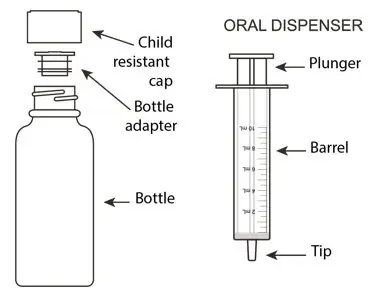 |
| Step 1: With the child-resistant cap on the bottle, shake the bottle well for about 5 seconds before each use. |  |
| Step 2: Open the bottle by pressing downward firmly on the child-resistant cap and turning it counter-clockwise. Do not throw away the child-resistant cap. | 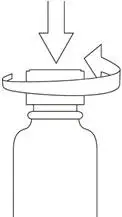 |
| Step 3: Check the dose in milliliters (mL) as prescribed by your healthcare provider. Find this number on the oral dispenser. | 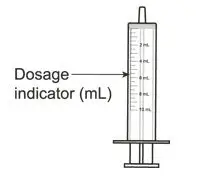 |
| Step 4: Push the plunger down toward the tip of the oral dispenser. | 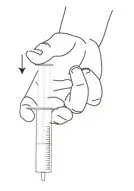 |
| Step 5: With the bottle in an upright position, insert the oral dispenser into the bottle adapter opening until firmly in place. | 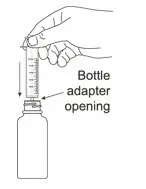 |
| Step 6: Carefully turn the bottle upside down with the oral dispenser in place. Pull the plunger to withdraw the prescribed dose. If you see air bubbles in the oral dispenser, fully push in the plunger so that the oral solution flows back into the bottle. Then withdraw your prescribed dose of VALCYTE for oral solution. | 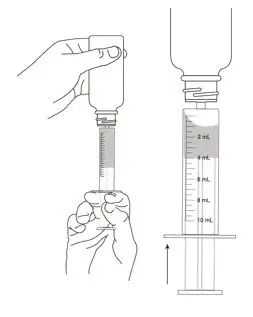 |
| Step 7: Leave the oral dispenser in the bottle adapter and turn the bottle to an upright position. Slowly remove the oral dispenser from the bottle adapter. | 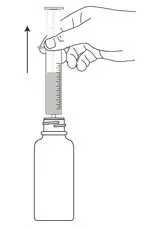 |
Step 8:Give or take the dose of VALCYTE for oral solution.
| 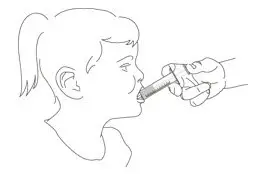 |
| Step 9: Put the child-resistant cap back on the bottle. Return the bottle back to the refrigerator. | 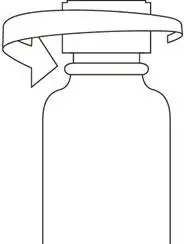 |
Step 10: Rinse the oral dispenser with tap water after each use.
|  |
| 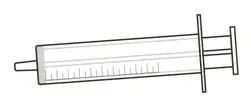 |
How should I store VALCYTE for oral solution?
- Store solution in the refrigerator at 36°F to 46°F (2°C to 8°C) for no longer than 49 days.
- Do not freeze.
This Patient Information and Instructions for Use have been approved by the U.S. Food and Drug Administration.
VALCYTE is a registered trademark of CHEPLAPHARM Arzneimittel GmbH.
Distributed by:
H2-Pharma, LLC
Montgomery, AL 36117, USA
Licensed by:
CHEPLAPHARM Arzneimittel GmbH
Ziegelhof 24, 17489 Greifswald, Germany
Revised: 04/2023
For more information call 1-866-946-3684.
© 2023 CHEPLAPHARM Arzneimittel GmbH. All rights reserved.
| VALCYTE
valganciclovir tablet, film coated |
||||||||||||||||||||||
|
||||||||||||||||||||||
|
||||||||||||||||||||||
|
||||||||||||||||||||||
|
||||||||||||||||||||||
|
||||||||||||||||||||||
|
||||||||||||||||||||||
| VALCYTE
valganciclovir hydrochloride powder, for solution |
||||||||||||||||||||
|
||||||||||||||||||||
|
||||||||||||||||||||
|
||||||||||||||||||||
|
||||||||||||||||||||
|
||||||||||||||||||||
|
||||||||||||||||||||
| Labeler - H2-Pharma, LLC (028473634) |
| Registrant - CHEPLAPHARM Arzneimittel GmbH (329834878) |
| Establishment | |||
| Name | Address | ID/FEI | Business Operations |
|---|---|---|---|
| F. Hoffmann-La Roche AG | 482242971 | ANALYSIS(61269-480, 61269-485) , API MANUFACTURE(61269-480, 61269-485) | |




